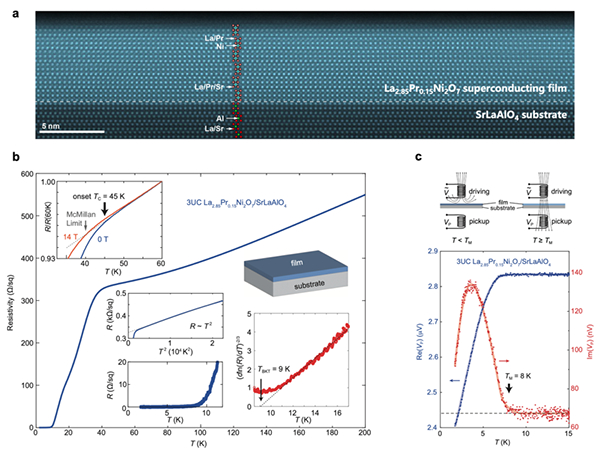Supported by the National Natural Science Foundation of China (Grant Nos. 92265112, 12374455, 52388201), a joint research team from Southern University of Science and Technology, Quantum Science Center of the Guangdong-Hong Kong-Macao Greater Bay Area, and Tsinghua University, led by Professor Zhuoyu Chen and Professor Qi-Kun Xue, has achieved a breakthrough in the field of high-temperature superconductivity. Using fully domestic equipment and self-developed experimental techniques, the team realized superconductivity in nickelate thin films under ambient pressure, with an onset transition temperature exceeding 40 K, and observed both zero resistance and diamagnetism. These findings were published in Nature on February 17, 2025, titled “Ambient-pressure superconductivity onset above 40 K in (La,Pr)3Ni2O7 films” at https://www.nature.com/articles/s41586-025-08755-z.
The quest for higher-temperature superconducting materials has been a driving force in international scientific communities since the discovery of superconductivity in 1911. Conventional superconductors, limited by the 'McMillan limit' of 40 K, eventually yielded to cuprate and iron-based compounds, now recognized as high-temperature superconductors. However, even after nearly four decades of intensive research, the complex mechanisms behind this phenomenon remain elusive. Nickelates have recently emerged as promising candidates. In 2019, Professor Harold Hwang's team at Stanford University observed superconductivity in square-planar infinite-layer nickelate thin films for the first time, though their superconducting temperatures remained below 40 K at ambient pressure. In 2023, Chinese scientists reported liquid-nitrogen-temperature superconductivity in nickelate bulk materials, albeit under extreme pressures exceeding 100,000 atmospheres, a feat that garnered widespread international attention. This achievement highlighted a critical global challenge: achieving ambient-pressure high-temperature superconductivity.
To address this challenge, the research team employed their self-developed “gigantic oxidative atomic-layer-by-layer epitaxy” (GOALL-Epitaxy) technique. Under oxidation conditions 10,000 times stronger than conventional methods, they achieved precise atomic-layer growth with controlled stoichiometry, constructing complex-structured, thermodynamically metastable nickelate thin films with high crystalline quality (Figure a). By utilizing substrate-induced strain, the team further stabilized high-pressure lattice structures under ambient conditions. After more than 1,000 trials, they successfully demonstrated ambient-pressure superconductivity in nickelate thin films. Comprehensive electromagnetic transport measurements confirmed the coexistence of zero resistance and diamagnetism (Figure b,c), validating the superconducting state. Notably, Professor Hwang’s team at Stanford independently observed ambient-pressure superconductivity in nickelate films with different chemical compositions but similar crystal structures, further corroborating this phenomenon.
This breakthrough establishes nickelates as the third high-temperature superconducting material system, after cuprates and iron-based compounds, to achieve superconductivity beyond the McMillan limit at ambient pressure. Furthermore, this work offers a novel pathway toward unraveling the long-standing enigma of high-temperature superconductivity mechanism.

Figure (a) Scanning transmission electron microscopy image of a superconducting (La,Pr)3Ni2O7 thin film grown on a SrLaAlO4 substrate. (b) Resistivity-versus-temperature curve. (c) Mutual inductance measurement of diamagnetism.

Add: 83 Shuangqing Rd., Haidian District, Beijing, China
Postcode: 100085
Tel: 86-10-62327001
Fax: 86-10-62327004
E-mail: bic@niballiance.org
京ICP备05002826号 文保网安备1101080035号 Copyright 2017 NSFC, All Right Reserved